Sorry for once again taking away from the ACA thread. I enjoy the conversation, but also I know how difficult it is to find relevant information about a build in an enormous thread. So, this will be my last post on the topic here. I’m happy to carry on in another thread. Lots of great thoughts.
@TungstenAudio's and @Extreme_Boky - I agree 100% re: how one might determine if they prefer a piece of gear over another and/or if it impresses them, and I love the comment re: why one listens. @TA - I echo @Toopy’s +100. Well said, sir.
Someone at BAF said something akin to "We like the sound of what we know". It struck me as interesting in the context of comparing gear that the advantage may go to the incumbent, particularly when A/Bing short snippets. It might take some time to "get used" to a new piece of kit and let it do its magic. I had usually considered the opposite to be true - essentially that I'm going to love whatever new shiny piece of gear I get... because it's new and shiny. I have no idea if either of those things are true. People are funny, and I'm a total loon.
Either way, I do blind listening over both short (less than the length of a song sometimes) and prolonged periods (weeks). I'm neither vilifying nor defending any particular method to do A/Bs or even if they should or should not be done. What people do in the privacy of their own home with their audio gear is none of my business.
However, here is what I considered a fun finding: I thought I preferred one amp over another after a few weeks listening to each of them. I listened a couple weeks with one, then a couple weeks with the other. Turns out - it was the same amp. Call it a false positive or beta error depending on one’s null hypothesis. Or… maybe Venus was in retrograde and that made me hear a difference.
I suppose what I'm getting at is - personally, I'd like to see if I can reliably tell the difference between some of my gear. If I can reliably tell the difference, is my preference consistent? If my preferences are consistent, is there anything common about the gear I prefer or *gasp* how it measures? I find that pursuit enjoyable. I can easily see why others would not. I can also see why many would question the intent nevertheless the methods.
Whether my antics have any foundation in science is a bit irrelevant. I do it for fun, and I would never be arrogant enough to assume that results I obtain would ever apply or even be relevant to anyone else. I actually find it funny when people ask my opinion re: how gear sounds. Heck for all any of you know, I could be deaf in one ear and have an effective hearing range from 1000 to 5000Hz.
In closing and most importantly, I’d never let my fun take away from allowing myself to be “entertained, and even lost in the flow of something transcendent of the mundane”.
After all, that’s what it’s all about.
 and thanks for the fun.
and thanks for the fun.
@TungstenAudio's and @Extreme_Boky - I agree 100% re: how one might determine if they prefer a piece of gear over another and/or if it impresses them, and I love the comment re: why one listens. @TA - I echo @Toopy’s +100. Well said, sir.
Someone at BAF said something akin to "We like the sound of what we know". It struck me as interesting in the context of comparing gear that the advantage may go to the incumbent, particularly when A/Bing short snippets. It might take some time to "get used" to a new piece of kit and let it do its magic. I had usually considered the opposite to be true - essentially that I'm going to love whatever new shiny piece of gear I get... because it's new and shiny. I have no idea if either of those things are true. People are funny, and I'm a total loon.

Either way, I do blind listening over both short (less than the length of a song sometimes) and prolonged periods (weeks). I'm neither vilifying nor defending any particular method to do A/Bs or even if they should or should not be done. What people do in the privacy of their own home with their audio gear is none of my business.
However, here is what I considered a fun finding: I thought I preferred one amp over another after a few weeks listening to each of them. I listened a couple weeks with one, then a couple weeks with the other. Turns out - it was the same amp. Call it a false positive or beta error depending on one’s null hypothesis. Or… maybe Venus was in retrograde and that made me hear a difference.
I suppose what I'm getting at is - personally, I'd like to see if I can reliably tell the difference between some of my gear. If I can reliably tell the difference, is my preference consistent? If my preferences are consistent, is there anything common about the gear I prefer or *gasp* how it measures? I find that pursuit enjoyable. I can easily see why others would not. I can also see why many would question the intent nevertheless the methods.
Whether my antics have any foundation in science is a bit irrelevant. I do it for fun, and I would never be arrogant enough to assume that results I obtain would ever apply or even be relevant to anyone else. I actually find it funny when people ask my opinion re: how gear sounds. Heck for all any of you know, I could be deaf in one ear and have an effective hearing range from 1000 to 5000Hz.
In closing and most importantly, I’d never let my fun take away from allowing myself to be “entertained, and even lost in the flow of something transcendent of the mundane”.
After all, that’s what it’s all about.
 and thanks for the fun.
and thanks for the fun.
Last edited:
In closing and most importantly, I’d never let my fun take away from allowing myself to be “entertained, and even lost in the flow of something transcendent of the mundane”.
After all, that’s what it’s all about.
and thanks for the fun.

I like your writing very much. Good sense of humor, wonderful self-irony, and a perfect balance between enjoying playing with the gear and enjoying listening to the music.
so another one:
 !
!
I like your writing very much. Good sense of humor, wonderful self-irony, and a perfect balance between enjoying playing with the gear and enjoying listening to the music.
so another one:!
I agree that was a very pleasing post.
With another one it will sound a lot better

christmas-present, please?
I wish there was kind of a ACA-cook-book (no, not this way
this way  ), a guide for us noobs which could help us find (and understand) the various possibilities to manipulate this beast a bit.
), a guide for us noobs which could help us find (and understand) the various possibilities to manipulate this beast a bit.
While I write it, I realize it's hardly possible because it's still an amp, but I still wish there was something like this around. Because you know, I know I will do something. I'll most probably follow TungstenAudio's guideline, not only because he seems to really have improved the ACA, but also because he tells me what to put where to get a result.
I'm reluctant to accidentally cook my ACA, so I won't dare touch it without a nanny
 .
.
Here's the cool guide from TungstenAudio ( here's the schematic and here's the story to it ) as a starter, but this guy knows how to jiggle his iron.
There are many many other contributions and developments, but spread all over the places (just like on an artists desk ) and most suggestions are either surgical or extremely nerdy (can I say that?)
) and most suggestions are either surgical or extremely nerdy (can I say that?)
dreaming of jiggling an iron: david
The ACA is so easy and cheap to modify a person dose not have go to Mouser or Digikey high shipping and high end Brand name part.
A beginner can swap parts and make magic smoke to your harts content experimenting changing sound and learning at the same time.
I wish there was kind of a ACA-cook-book (no, not
 this way
this way While I write it, I realize it's hardly possible because it's still an amp, but I still wish there was something like this around. Because you know, I know I will do something. I'll most probably follow TungstenAudio's guideline, not only because he seems to really have improved the ACA, but also because he tells me what to put where to get a result.
I'm reluctant to accidentally cook my ACA, so I won't dare touch it without a nanny
Here's the cool guide from TungstenAudio ( here's the schematic and here's the story to it ) as a starter, but this guy knows how to jiggle his iron.
There are many many other contributions and developments, but spread all over the places (just like on an artists desk
dreaming of jiggling an iron: david
I wished I read all the information on planet10 website before I built my first f
Yes I’m running bridge monos. Back when I was first built that speaker cabinet combination I was just discovering full range. After reading planet 10 webpages and all his related links for information I felt very enlightened. but with all that information now I have 10,000 more questions. And my bucket list now includes software and hardware for performing speaker measurements. I will finish building my LX mini line side crossover. Experiment with bi-amping and adding a tweeter to my BK-20 cabinet and learn how to master the software and hardware for taking speaker measurements properly been doing a lot of reading about that and watching videos on set up.
By the way I have a future question for you planet 10. Is there such a thing does physics allow a high-efficiency speaker relatively low wattage to be a subwoofer in the 17 Hz to 80 Hz region. So far by my reading and my knowledge of physics and practical cost for a given size it sounds like there’s not enough call in the market to make it a financially profitable product. And to be a tight accurate musical sound in speaker in a sealed box would probably have to be god awfully large. But if it exists I’m interested.
The BK-20 is a horn for the FE206 (pre 2000 version, from before decent horn modelers), and is not the best cabinet for this driver. Do note that the FE206En is 96 dB, but as important is the kind of speaker that likes a bit higher output impedance amplifier (ie the impedance curve is synergistic with the amp output impedance and the FR (when measured with a low output impedance amplifier)).
I suspect that bridged ACA (output impedance is R*2), will be better than a singe (R) or a pair in parallel mono (R/2).
dave
Yes I’m running bridge monos. Back when I was first built that speaker cabinet combination I was just discovering full range. After reading planet 10 webpages and all his related links for information I felt very enlightened. but with all that information now I have 10,000 more questions. And my bucket list now includes software and hardware for performing speaker measurements. I will finish building my LX mini line side crossover. Experiment with bi-amping and adding a tweeter to my BK-20 cabinet and learn how to master the software and hardware for taking speaker measurements properly been doing a lot of reading about that and watching videos on set up.
By the way I have a future question for you planet 10. Is there such a thing does physics allow a high-efficiency speaker relatively low wattage to be a subwoofer in the 17 Hz to 80 Hz region. So far by my reading and my knowledge of physics and practical cost for a given size it sounds like there’s not enough call in the market to make it a financially profitable product. And to be a tight accurate musical sound in speaker in a sealed box would probably have to be god awfully large. But if it exists I’m interested.
Just waiting on Toroids to complete a couple of cool power supplies to sit on my ACAs. Hard to know how much sound improvement I'll get but it will tidy up the number of wall warts and bricks lying around the place. PS will be a decent distance from other equipment sat on the ACA on a wall shelf behind each huge floor stander. Toroids will fill the holes with 5mm clearance front and back for ventilation.
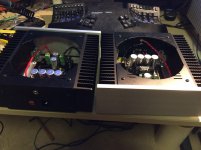
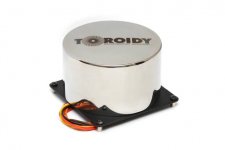


... but with all that information now I have 10,000 more questions.
Something we learn as we learn, how much more we have to learn.
Ask away. Just in a thread more appropriate to the topic. Lots of people to chime in with useful information.
Experiment with bi-amping and adding a tweeter to my BK-20
Biamping can be fun. Getting a tweeter to integrate that high up can be tricky, but will add air up top if you get it right.
I am eagerly awaiting the B4 inspired diyAudio Store XO, i imagine. a stack of ACP+/AXO/3 x ACA (2 in mono), with a nice WAW.
Is there such a thing does physics allow a high-efficiency speaker relatively low wattage to be a subwoofer in the 17 Hz to 80 Hz region
Because of Hoffman’s Iron Law, low and efficient means the speaker has to be BIG. I alwasy imagine a pair of big horns using the entire wall as the mouths. The size is too small (in most rooms) for 17 Hz, but they would effectively be corner loaded so 8x effective mouth area. Or use the room next door (or underneath) as a big IB.
dave
Because of Hoffman’s Iron Law, low and efficient means the speaker has to be BIG. I alwasy imagine a pair of big horns using the entire wall as the mouths. The size is too small (in most rooms) for 17 Hz, but they would effectively be corner loaded so 8x effective mouth area. Or use the room next door (or underneath) as a big IB.
dave
I have Seas 10" subwoofer with matching 10" passive radiator in the bass enclosures that support each main speaker. They are currently driven by plate amps that allow me to set the gain and crossover phase etc.
Each passive radiator has a bolt on the back to enable weight to be added (in the form of washers) this can be used to lower the frequency. I've never played with that. The advantage for me and reason for a Sub and Passive combo was that there was no need to try and tune the port lengths that would have been required without the passives. How low can you go adding weight to passive radiators and what's the overall bass effect.
I've read that you should have double the surface area of your sub for your passive but this is a MFR recommended set up.
Did I also read that your ears are less sensitive to bass so you can get away with less "Fidelity" in that Area. Plate Amp works fine and i'd need a cross over and probably a lot more Watts than just one ACA can deliver per speaker to keep up with the horn output.
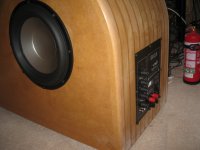
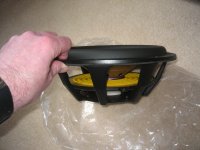
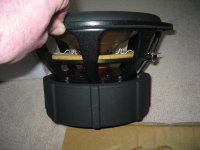
Just waiting on Toroids to complete a couple of cool power supplies to sit on my ACAs. Hard to know how much sound improvement I'll get but it will tidy up the number of wall warts and bricks lying around the place. PS will be a decent distance from other equipment sat on the ACA on a wall shelf behind each huge floor stander. Toroids will fill the holes with 5mm clearance front and back for ventilation.
Your ACAs are going to look really nice with these Toroidy. Mine uses the original PSU brick and it get a lot warmer than my F5, so I will be very interested to see what kind of temperature you finally have with this set-up.
Your Acas are going to look really nice with these Toroidy. Mine uses the original PSU brick and it get a lot warmer than my F5, so I will be very interested to see what kind of temperature you finally have with this set-up.
PSU Is in it's own chassis so I'm not anticipating heat problems - I took this photo with 20mm standoffs between the units before whilst waiting but will bolt it all together with 10mm when the toroids arrive then bolt to the shelf to make it Earthquake resistant :
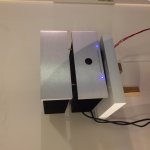
If you live in Wellington NZ bolt your bookshelves to the wall and look both ways for busses when crossing the road
Last edited:
The whole thing is very temperature sensitive. I found the best way was to have it all sitting flat with a pair of multimeters hooked up at the same time. Once dialed in I listened with the amp sitting in free space. I moved the setup into a more permanent position later between some shelves and the heat sinks got very hot because there was less air flow in that position. I pulled them out and re checked the voltages when they where hot and got about 19 with hot heatsinks on both sides. Make sure you have even airflow on both sides when testing and make sure there’s plenty of ventilation around the Amp once in use.
Hi I have just finished Amp camp 1,6 And when i adjust Q1 to 10vdc on the center pin.
I get 19vdc over the center pin of Q2. Is this right. I have not tried it with speakers connected. Because i am a bit worried about the high votltage on Q2
This is correct. The centre pin of Q2 (the Drain) is connected to the + (positive) supply, so will be 19 or 24 volts depending on which power supply you use.
Can’t one just substitute a 24V PS in the old one and get 8w?
Wow, that would be some power!

No, not quite.Can’t one just substitute a 24V PS in the old one and get 8w?
...
dave
The newer boards (v 1.6 from the store) have an extra resistor, R15, that helps the Mu follower current source provide more dynamic current to the output. Even then, 8 Watts is a stretch for a single stereo amp. Using two as monoblocks can give noticeably better dynamics, detail and stereo separation. That would be my recommendation.
You might also consider the component substitutions that I have suggested. These lower the output resistance and reduce the feedback slightly to allow more power to be delivered to the speakers. My goal was specifically to improve the dynamics of the ACA when driving my medium efficiency speakers.
Last edited:
- Home
- Amplifiers
- Pass Labs
- Amp Camp Amp - ACA
